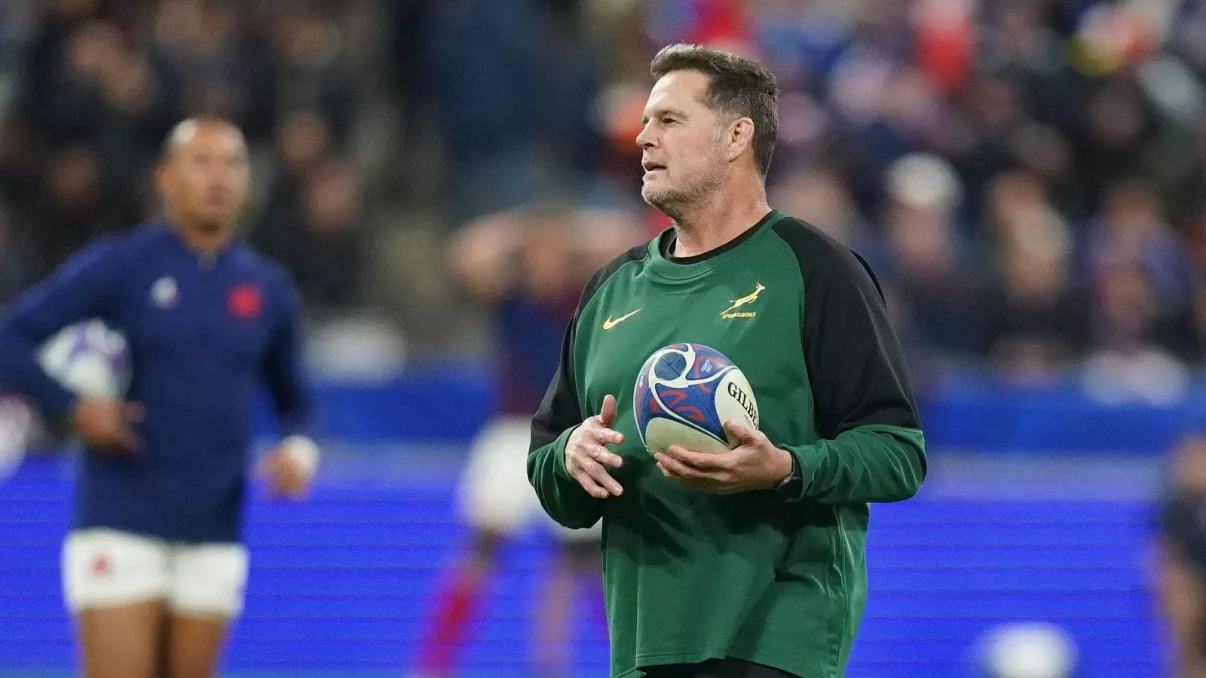Rassie Erasmus says there is no excuse for club and school coaches who believe new tackle height laws for participation rugby are difficult to instil.
Springbok coaches and players worked incredibly hard at the Rugby World Cup – and successfully – to eradicate unnecessary penalties and cards for illegal and dangerous tackles from their game, having identified conceding such penalties as a high risk to success.
As a result, the Boks managed to lift the Webb Ellis Cup on 28 October 2023 in Paris after a tournament in which they tackled lower than many of the other participating teams, limiting penalties against them for dangerous or illegal tackles.
New laws to make rugby safer at school and club level were approved by the members of the South African Rugby Union at a general council meeting late last year and have come into force since the start of the year.
The updated laws for amateur rugby relate to lowering of the maximum legal tackle height, while also outlawing potentially dangerous ball-carrying actions and techniques.
Although these new laws are not applicable at senior professional level, Rassie Erasmus, SA Rugby's Director of Rugby, said the Bok coaching staff identified lowering the tackle-height as a critical step if they wanted to win the tournament.
"Tackling lower is coachable, so this cannot be used as an excuse – you need to coach and practise correct technique," said Erasmus.
"We therefore built it into our conditioning and technical preparation for the tournament. You cannot simply tackle lower without focusing on correct technique.
"Tackle-bags are only training tools and should not dominate your tackle-training. You do need to work more on moving bodies, but within a controlled space, where players learn to adjust their height within a more dynamic game-like situation."
Erasmus said it was imperative to condition players to keep their heads up and drop their height quickly when preparing to tackle an opponent.
"Fitness becomes a critical requirement to continue tackling lower over the course of a match, so appropriate fitness and conditioning is critical," he said.
"Upright ball-and-all tackles are not practical under these laws, so you need to adapt the way you coach the tackle. Wrap tackles bring players more upright into contact, which shares headspace in a high-risk situation, and increases the risk of head-contact and concussions.
"Whether we like it or not, at some stage the laws are going to change worldwide around tackle-height, so we need to be part of the solution and not having to play catch-up after the laws have already been made."
According to Erasmus – and in line with World Rugby's request for unions to consider and trial law variations of lowered tackle-heights, with the SA Rugby law variations adopted late last year – the local governing body can drive a practical change, and potentially extend these to the rest of the world if successful in lowering head-contacts and catastrophic tackle-related injuries. There are several other international unions also trialling variations of lowered tackle-height laws.
"This is not going to happen overnight, and this is going to take time for everyone to get this under wraps," said Erasmus.
"We have limited time to create a significant behaviour change, and therefore a phased sanction-approach is not ideal and will not necessarily be effective. The hard sanction-approach to be implemented will lead to an initial increase in penalties, but once players, coaches, and referees get to grips with these changes, players' behaviour will adapt, players will be penalised less, and this will become a more appealing game.
"As custodians of the game, we have a responsibility to follow the scientific evidence to ensure that players are well-protected within a physical, collision-based, contact-sport such as rugby union.
"That means that although one appreciates the gladiatorial nature of the game, this should not increase the risk disproportionately to the players. The current law changes are trying to maintain the physical essence of the game while simultaneously lowering the risk of concussions, catastrophic head, neck, and spinal injuries and long-term brain-health complications.
"Yes, the new laws will change some parts of the game, such as more offloads, running rugby and open play, but will not detract from the physicality and confrontational nature of what defines rugby union.
"By limiting the ball carrier's body height and position into contact there is a shift away from the tackler being the sole responsible person for the safety of the tackle contest. This is not stopping the ball carrier from taking the ball into contact; the tackler must however always have a visible target to hit that is safe. This keeps both tackler and ball carrier safe in the contest."
A scientific analysis of South African rugby union tackle-related catastrophic injury data showed that a low-positioned ball carrier entering the tackle contest in a low forward-bent position increased the risk of catastrophic head, neck, and spine injuries to both tacklers and ball carriers alike. Therefore, SA Rugby included the law adaption to restrict the way in which the ball carrier is allowed to carry the ball into contact.
Erasmus added: "Get your players to do the Tackle-Height Change Education module on MyBokSmart, so that your players can also have a better understanding of why these laws have been implemented. This will lead to more buy-in.
"Yes, you can get a concussion while tackling at the hips, but the chance of getting a concussion while tackling at the hips is sizably lower than when tackling upright or sharing headspace.
"Those who adopt these law changes early on, will reap the benefits sooner, improve safety, have less head contact, and a better game.
"With a regulated and lengthy standdown period from rugby with all suspected and confirmed concussions, adopting these new laws will be in the players' and the teams' best interests, as one of the main purposes are to reduce the number of head contacts and concussions."









